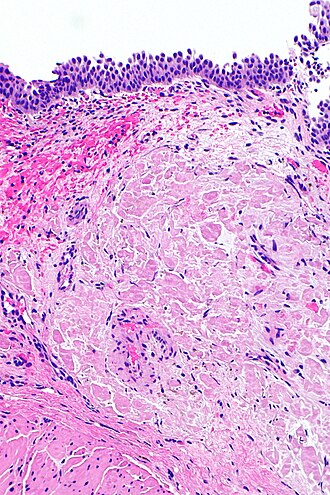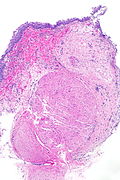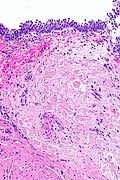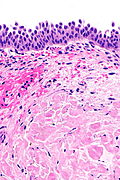Difference between revisions of "Urinary bladder amyloidosis"
Jump to navigation
Jump to search
| Line 42: | Line 42: | ||
==Microscopic== | ==Microscopic== | ||
Features: | Features: | ||
*Lamina propria with amyloid | *Lamina propria with amyloid. | ||
**Amyloid = amorphous, paucicellular material that is [[pink on H&E]], classically has "cracked" appearance. | |||
***"Cracked": irregular fragments where the edges and centre of fragments are homogeneous. | |||
DDx: | DDx: | ||
Revision as of 13:04, 4 October 2015
| Urinary bladder amyloidosis | |
|---|---|
| Diagnosis in short | |
 Urinary bladder amyloidosis. H&E stain. | |
|
| |
| Synonyms | amyloidosis of the urinary bladder |
|
| |
| LM | lamina propria with amyloid (amorphous, paucicellular, pink material on H&E - classically "cracked") |
| LM DDx | fibrosis, fibrin, leiomyoma |
| Stains | Congo red +ve |
| Site | urinary bladder |
|
| |
| Prevalence | very rare |
| Radiology | thickened bladder wall |
| Clin. DDx | other urinary bladder tumours - esp. malignant ones |
Urinary bladder amyloidosis, more formally primary urinary bladder amyloidosis, is a rare benign condition of urinary bladder that can mimic cancer of the urinary bladder.[1]
General
- Primary bladder amyloidosis is rare - approximately 200 reported cases as of 2014.[1][2]
- Systemic amyloidosis should be excluded.[2]
- May clinically mimic bladder cancer.[1]
Gross
- Urinary bladder wall thickening.[1]
Microscopic
Features:
- Lamina propria with amyloid.
- Amyloid = amorphous, paucicellular material that is pink on H&E, classically has "cracked" appearance.
- "Cracked": irregular fragments where the edges and centre of fragments are homogeneous.
- Amyloid = amorphous, paucicellular material that is pink on H&E, classically has "cracked" appearance.
DDx:
- Fibrin.
- Fibrosis.
- Leiomyoma.
Images
Stains
- Congo red +ve.
Sign out
Urinary Bladder, Transurethral Resection: - Urothelial mucosa with amyloidosis and mild chronic inflammation. - Benign muscularis propria present. - NEGATIVE for urothelial carcinoma in situ. - NEGATIVE for evidence of malignancy. Comment: Congo red staining and polarization confirm the presence of amyloid. Primary bladder amyloidosis is rare; systemic causes of amyloidosis should be considered.
See also
References
- ↑ 1.0 1.1 1.2 1.3 Kobayashi, T.; Roberts, J.; Levine, J.; Degrado, J. (2014). "Primary bladder amyloidosis.". Intern Med 53 (21): 2511-3. PMID 25366012.
- ↑ 2.0 2.1 Schou-Jensen, KS.; Dahl, C.; Pilt, AP.; Azawi, NH. (Oct 2014). "Amyloidosis in the bladder: three cases with different appearance.". Scand J Urol 48 (5): 489-92. doi:10.3109/21681805.2014.920414. PMID 24857645.



